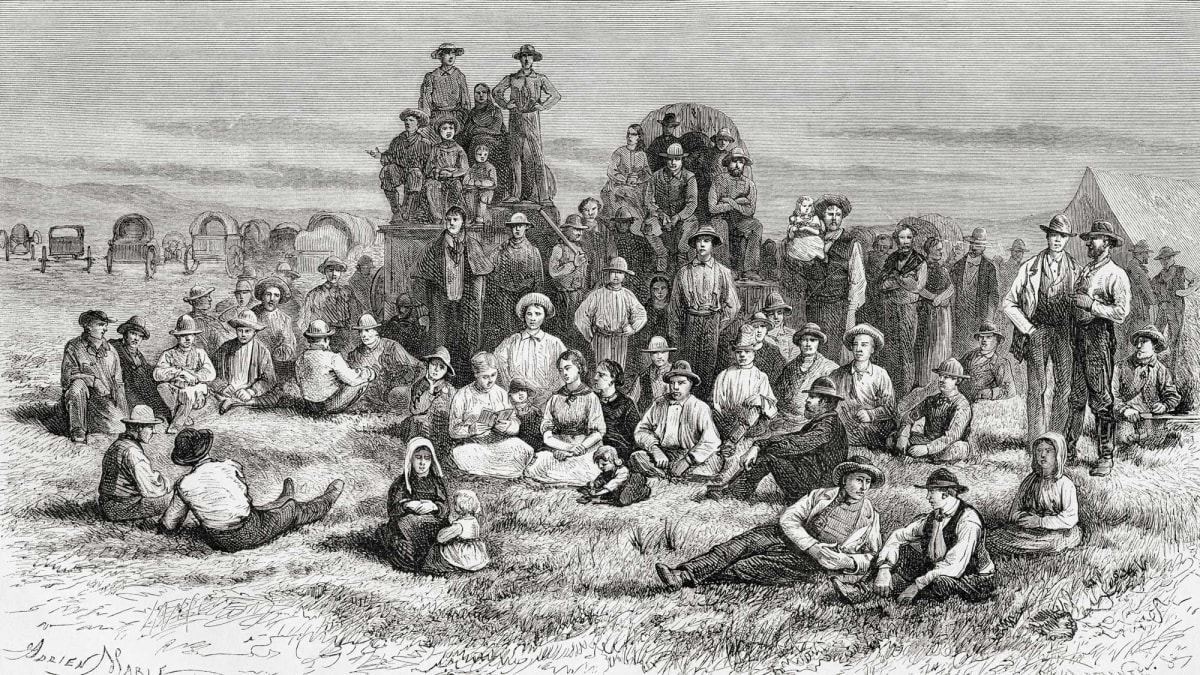
In early 1850, Church leaders advised emigrants that pioneer companies would travel on a new route on the south side of the Platte River. By taking this new route they avoided some river crossings on the north side that had proved dangerous because of high water in the previous year. They also expected to receive additional military protection on a new army supply road. This was a factor in their decision because they wanted to avoid conflict with the Plains Indians, who had been agitated during the 1849 California gold rush. The 200-mile long army road connected "Old Fort Kearny," located 50 miles below Kanesville on the Missouri River, to "New Fort Kearny" following the south side of the Platte River to the west.
The first company to depart from Kanesville was led by Milo Andrus. The company, composed of 206 people and about 55 heavily-loaded wagons, traveled 18 miles south on the east bank of the Missouri River to the Bethlehem Ferry (across the river from present-day Plattsmouth, Nebraska). There they crossed the Missouri River and spent a few days organizing the company. On June 3 they left their camp on the west side of the ferry and followed the Plattsmouth-Fort Kearny trail south. After crossing Weeping Water Creek they forged a new trail west where they connected with the northward-arching new military road, which became known as the Ox-Bow Trail.
When they reached Salt Creek (near present-day Ashland, Nebraska), they found that high waters had washed out the bridge so they spent a few days building a raft on which they crossed with their wagons. At Salt Creek his place they also had a small outbreak of measles.
The Andrus company was the only 1850 Mormon company to take the original route of the military road that crossed the drainage now known as Wahoo Creek. Later Mormon companies in 1850 took a cutoff trail (near present-day David City and Bellwood, Nebraska) that saved them 12 miles. The Andrus Company passed a large Indian village at Linwood, Nebraska, and reached the Platte at Skull Creek (near present-day Morse Bluff, Nebraska). At this point they followed the south bank of the Platte River a hundred miles west past Grand Island where they joined with the Oregon Trail coming north from Missouri. They then continued 15 more miles to "New Fort Kearny", which they reached on June 23, although the army reserved grazing rights and companies weren't permitted to camp within a mile of the fort. Continuing up the south side, they reached the Lower Crossing of the South Platte (in the vicinity of the present-day town of Hershey, Nebraska), where they began crossing over to the north side.
The Andrus company was the only Mormon company to ford here in 1850. On July 4, they succeeded in crossing the last of their wagons and traveled from there to Fort Laramie on the north side. On this side of the river they found that the grass was sparse. 1850 was a big year for overland travel as about 50,000 people bound for Oregon and the California gold fields started before the Mormon companies. They overgrazed the plains grasses, particularly on the north side of the Platte River. Cholera was epidemic among the companies bound for California and Oregon, and many graves lined the road. However, Andrus's company was spared and there was only one death in the company--a gold digger bound for California. They were fortunate too when a young girl survived a serious head injury after being run over by a wagon.
At the fifth crossing of the Sweetwater, they met four men who were sent out by Brigham Young to locate better routes and help guide the companies to the Salt Lake Valley. Elijah Ward stayed with the company and guided them on some selected new routes. Their first departure from the established road bypassed the Rocky Ridges by veering to the north through a draw. It reportedly had an abundance of feed and water, but the ground was rough and it was only a mile shorter than the ridge road, which it rejoined just east of Rock Creek. The second departure took them on a straight course leading from a point three miles below Pacific Springs. Ward was supposed to guide them 10 miles to rejoin the old road where it crossed the Big Sandy. Unfortunately he deviated from the planned new route and the company had to travel an additional 20 miles without water. Generally they enjoyed good weather except for a severe snowstorm at Green River on August 17. When the wagon train exited Emigration Canyon and arrived in Salt Lake City on August 30, Andrus sported festive banners on either side of his wagon that read "Holiness to the Lord" and "Hail to the Governor of Deseret."